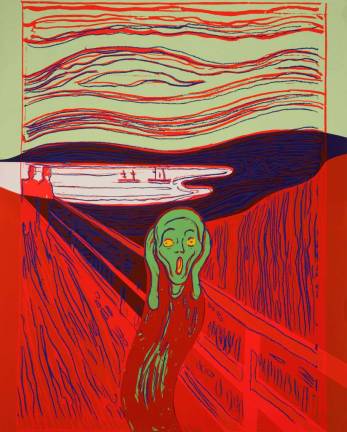Pop Meets Expressionism

Warhol and Munch: Outsiders together at last
Andy Warhol was a great champion of the Outsider: is it any surprise that he eventually made his own version of that most alienated piece of art, The Scream? It's all a little bit surreal, of course, but right now Scandinavia House is exhibiting a series of Warhol prints based on four of Edvard Munch's best-known lithographs. (Munch's originals are also included, for easy comparison.) Looking at the Warhol prints is like hearing, say, the Doors sing Kurt Weil. Even where the cover slavishly imitates the original, it's a world apart. But Warhol's prints are interesting, not just for the ways they differ from Munch, but for the way they often bolster him.
I've never particularly liked Munch's The Brooch. It's a portrait of Eva Mudocci, a famous violinist of the period, but it may as well have been any old fantasy. Munch's piece is all dreamy eyes and white skin and clouds of thick dark hair, a romantic haze. I was relieved when Warhol came along, all 20th century directness, and put some color into Eva's face. All the lines in the piece stay the same, but what a difference a few colors ? bright yellow skin, a pink chin, there are a few different versions here -- can make! Eva has gone from bloodless dream to living, energetic woman -- it's hard not to think that Warhol's version is closer to the actual Eva.
I tried to remember Eva as I confronted Warhol's version of Munch's Madonna. The piece landed Munch in a lot of trouble, since it depicts a naked woman in the throes of passion; there's a grinning sperm in the bottom left-hand corner. Today, its shock value gone, the piece looks like a warm depiction of female desire. Warhol's response is aggressive, to say the least. He's turned the dark smudges around Madonna's eyes into sharp lines, so that the poor woman, who used to look blurry with passion, now looks bug-eyed. The shadows around her breasts look a bit like knife wounds in Warhol's version, and no matter what color scheme he tries, his Madonna looks like the victim of some awful crime.
Warhol's take on Munch's self-portrait was the least interesting piece in the show, to my mind. It's a faithful copy, turned out in a few colors and given the obvious distance of no longer being a self-portrait. But Warhol's Scream may be the best piece here. Munch's Scream is so hesitant: is the screamer overwhelmed by the natural world, or by the rigid society of men in top hats all around him? And then, it's a bit hard to see past all the naked self-pity. Warhol solves the problem neatly. He blurs all the straight lines ? the top hats, the bridge ? into a wavy, absurdly bright sunset. Civilization and nature blend together and our screamer is in the foreground, no longer a frightened victim, but a proud outsider. It feels like a parting gift, from one alienated artist to another.
MUNCH | WARHOL and the Multiple Image is on exhibit at Scandinavia House through July 27.